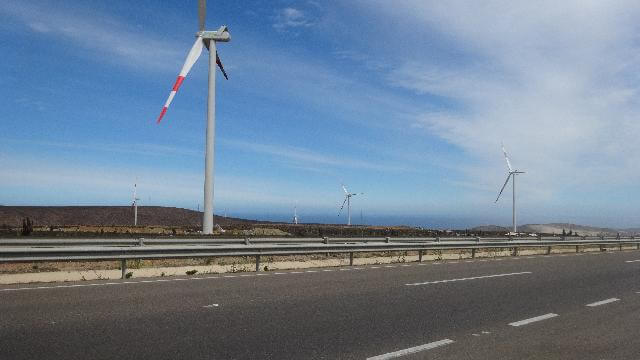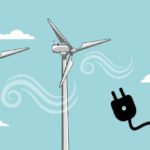Have you ever wondered, ‘How do wind turbines work on days when there is no wind?’ Well – this is when the battery saves the day.
A battery makes it possible for wind turbines to provide energy, even on days when there is no wind.
Batteries make it possible for wind turbines to provide an uninterrupted power supply.
There is a wide range of battery options. But the most commonly used battery type in wind turbines is lithium-ion batteries.
Lithium-ion batteries may provide several advantages that make them the popular battery choice. Yet they also have a few disadvantages.
Even a disadvantage relating to the sustainability of wind turbines.
Here is everything you need to know about the lithium used in wind turbines.
Why do wind turbines need batteries?
Wind turbines use the wind to produce electricity.
Wind turbines do this by using the wind to spin the blades of the turbine around a rotator. This will then spin a generator that will produce electricity.
To overcome the issue of a lack of wind resources and irregular wind resources.
Wind turbines make use of batteries to overcome these unavoidable issues.
Wind turbines connected and disconnected to the grid can both use batteries.
By using batteries in wind turbine systems, they provide two different functions.
Wind turbines are almost completely reliant on wind resources to produce electricity, which means that on the days when there is no wind, the wind turbine will not be able to produce any electricity.
By using batteries, you will be able to store electricity off-grid.
This overcomes the issue of too little or no wind resources available for wind farms.
Batteries also help wind turbines to stabilize their production of electricity.
This is necessary because wind speeds are not consistent. Wind turbines need consistent wind speeds to produce electricity.
What kind of batteries do wind turbines use?
As wind energy technology advances, the options of battery types are also growing.
The battery types that the majority of wind energy systems use include:
- Lithium-ion batteries (Li-Ion 101)
- Flow batteries
- Solid-state batteries
- Sodium sulfur batteries
Lithium batteries for wind turbines
Lithium-ion batteries are the popular choice used for wind energy systems.
The reason for this may be because there are no liquids contained in this battery type.
They are preventing any dangerous circumstances, such as explosions.
Lithium-ion batteries do not need a lot of maintenance.
This is another reason why it is the more popular battery choice. Another factor that makes it the popular choice for wind energy systems is its size.
Lithium-ion batteries are compact and can provide a lot of power.
Lithium batteries ensure that you have a reliable power system for your wind farm.
These batteries will keep your wind turbine blades rotating in emergencies.
The lifespan of a standard lithium-ion battery is approximately four years.
This includes the battery performing three discharges each day.
The lithium-ion battery is recyclable at the end of its lifespan.
You will need to take it to a proper recycling facility and not throw it out as wind turbines work towards sustainability.
So it only fits that lithium-ion battery is recyclable.
What are lithium batteries?
Lithium-ion batteries store a large amount of electricity while being small in size.
A wide variety of machines use lithium-ion batteries from cell phones, laptops, aerospace applications, and electric vehicles.
When a lithium-ion battery is in charge, it generates electricity.
This happens through the flow of charged particles.
This rechargeable battery has lithium-ions moving from negative electrodes passing an electrolyte. Which then passes to the positive electrode when discharging.
When the lithium-ion battery is recharging, this flow will reverse.
The lithium-ion battery is also efficient at generating electricity.
Which is another reason that makes it the more popular battery choice for wind turbines.
This is because it has a strong flow of electrons, which goes a long way.
Yet, there are several advantages and disadvantages of lithium-ion batteries, which are important to consider when looking at if this is the best battery option for wind turbines.
Advantages of lithium-ion batteries
- Energy density
Lithium-ion batteries have a high energy density. Which allows the wind turbines to operate while consuming power.
- Compact
The compact size and power that the lithium-ion batteries provide. Which is one of the biggest factors that make this battery the more popular option for wind turbines.
- Low maintenance
Lithium-ion batteries do not need a lot of maintenance. It makes them the perfect option for wind turbines that do need maintenance, which means that you will not have to worry about the battery and can focus on the wind turbine’s maintenance.
Disadvantages of lithium-ion batteries
- Lithium is a non-renewable resource.
Lithium is a nonrenewable resource. This limited resource takes an intensive mining process which takes a lot of energy.
This mining process is harmful to the environment. It can lead to the loss of biodiversity, soil erosion, and surface water contamination.
While wind farms are trying to reduce environmental pollution by reducing fossil fuels, this renewable energy source uses a non-renewable resource. Which may be causing more harm to the environment than good.
- Sensitive to temperatures
Lithium-ion batteries are sensitive to high temperatures during fast charging.
- Cost
Lithium-ion batteries can be relatively costly even though a wide variety of mass-produced devices use lithium-ion batteries.
In conclusion, wind turbines do make use of lithium.
The battery power system of the wind turbines uses lithium.
Batteries help with the stabilization of the production of electricity.
Which is necessary for times when the speed of the wind is not consistent.
Wind turbines also use batteries for the storage of electricity.
This comes in handy, especially when there are little or no wind resources available.
The battery ensures that there is an uninterrupted supply of energy.
Wind turbines have a wide range of batteries to choose from.
Yet lithium-ion batteries are the popular choice because of their advantages.
One of these advantages is the battery’s energy density.
Another advantage is the compact size of lithium-ion batteries and the fact that lithium-ion batteries are low maintenance.
There are also disadvantages to using lithium-ion batteries in wind turbines.
One of these disadvantages is the cost of the battery, which is relatively expensive.
Another disadvantage is that lithium-ion batteries are sensitive to temperatures.
Yet, one of the biggest disadvantages of using lithium-ion batteries relates to renewability.
Lithium-ion batteries contain lithium, which is a non-renewable resource.
This means that a big part of renewable energy is reliant on non-renewable resources.
While advances in wind energy technology are being made, we cannot ignore that wind energy needs lithium to work.
Once they find a suitable replacement, it will be a huge step forward for wind energy.
References:






